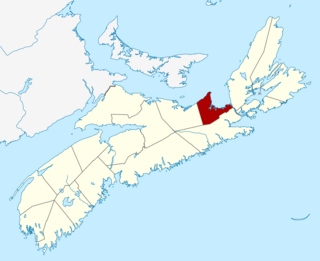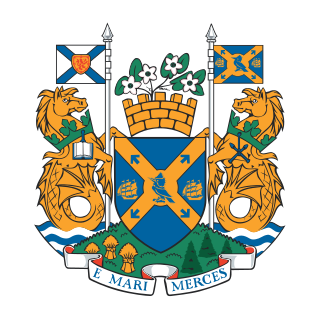The Nova Scotia Utility and Review Board or NSUARB is the independent tribunal and regulating arm of the Government of Nova Scotia.

A tribunal, generally, is any person or institution with authority to judge, adjudicate on, or determine claims or disputes—whether or not it is called a tribunal in its title. For example, an advocate who appears before a court with a single judge could describe that judge as 'their tribunal'. Many governmental bodies that are titled 'tribunals' are so described to emphasize that they are not courts of normal jurisdiction. For example, the International Criminal Tribunal for Rwanda is a body specially constituted under international law; in Great Britain, employment tribunals are bodies set up to hear specific employment disputes. In many cases, the word tribunal implies a judicial body with a lesser degree of formality than a court, to which the normal rules of evidence and procedure may not apply, and whose presiding officers are frequently neither judges nor magistrates. Private judicial bodies are also often styled 'tribunals'. However, the word tribunal is not conclusive of a body's function–for example, in Great Britain, the Employment Appeal Tribunal is a superior court of record.

The Government of Nova Scotia refers to the provincial government of the Canadian province of Nova Scotia. Nova Scotia is one of Canada’s four Atlantic Provinces, and the second-smallest province in Canada. The capital of the province, Halifax, is Nova Scotia's largest city and its political capital. Halifax is where the Province House, Canada’s oldest legislative building, is located.
NSUARB was established in 1992 following the amalgamation of the former Board of Commissioners of Public Utilities, the Nova Scotia Municipal Board, the Expropriations Compensation Board and the Nova Scotia Tax Review Board. It is governed under the Utility and Review Board Act. NSUARB reports directly to the Nova Scotia House of Assembly, currently through the Minister of Finance.

The Nova Scotia House of Assembly is one of two components of the General Assembly of Nova Scotia, the other being the Queen of Canada in Right of Nova Scotia represented by the Lieutenant Governor of Nova Scotia. It is the legislative branch of the provincial government of Nova Scotia, Canada. The assembly is the oldest in Canada, having first sat in 1758, and in 1848 was the site of the first responsible government in the British Empire.
NSUARB's responsibilities are quite broad and cover the following issues:
- automobile insurance
- electricity rates for Nova Scotia Power and other electrical utilities
- gaming
- Halifax-Dartmouth Bridge Commission
- liquor licensing
- motor carrier division - buses
- natural gas
- payday loans
- petroleum product pricing
- railways
- municipal water and sewer rates
- municipal electoral district boundaries
Nova Scotia Power Inc. is a vertically integrated electric utility in Nova Scotia, Canada. It is privately owned by Emera and regulated by the provincial government via the Nova Scotia Utility and Review Board (NSUARB). Nova Scotia Power Inc provides electricity to 500,000 residential, commercial and industrial customers in Nova Scotia.

A payday loan is a small, short-term unsecured loan, "regardless of whether repayment of loans is linked to a borrower's payday." The loans are also sometimes referred to as "cash advances," though that term can also refer to cash provided against a prearranged line of credit such as a credit card. Payday advance loans rely on the consumer having previous payroll and employment records. Legislation regarding payday loans varies widely between different countries, and in federal systems, between different states or provinces.

Water is a transparent, tasteless, odorless, and nearly colorless chemical substance, which is the main constituent of Earth's streams, lakes, and oceans, and the fluids of most living organisms. It is vital for all known forms of life, even though it provides no calories or organic nutrients. Its chemical formula is H2O, meaning that each of its molecules contains one oxygen and two hydrogen atoms, connected by covalent bonds. Water is the name of the liquid state of H2O at standard ambient temperature and pressure. It forms precipitation in the form of rain and aerosols in the form of fog. Clouds are formed from suspended droplets of water and ice, its solid state. When finely divided, crystalline ice may precipitate in the form of snow. The gaseous state of water is steam or water vapor. Water moves continually through the water cycle of evaporation, transpiration (evapotranspiration), condensation, precipitation, and runoff, usually reaching the sea.
This page is based on this
Wikipedia article Text is available under the
CC BY-SA 4.0 license; additional terms may apply.
Images, videos and audio are available under their respective licenses.

Antigonish County is a county in the province of Nova Scotia, Canada. It is located in northern Nova Scotia on the Northumberland Strait. The Town of Antigonish and Municipality of the County of Antigonish are the two largest incorporated municipalities in the county.

Mahone Bay is a town on the northwest shore of Mahone Bay along the South Shore of Nova Scotia in Lunenburg County. A long standing picturesque tourism destination, the town has recently enjoyed a growing reputation as a haven for entrepreneurs and business startups. The town has the fastest growing population of any municipality in Nova Scotia according to the 2016 census, experiencing 9.9% population growth.

Halifax Regional Council is the governing body of Halifax, formally known as the Halifax Regional Municipality (HRM). Halifax is governed by a mayor-council system, where councillors are elected from sixteen geographic districts though a first past the post system and the Mayor is elected via a municipality wide first past the post vote. Halifax Regional Council was formed in 1996 and consisted of twenty-three councillors and one mayor. It was reduced in size to sixteen councillors and the mayor in 2012. The council meets at Halifax City Hall.

The Cape Breton and Central Nova Scotia Railway is a short line railway operating in the Canadian province of Nova Scotia. CBNS operates of main line and associated spurs between Truro in the central part of the province to Point Tupper on Cape Breton Island.
John W. Morgan,, is a Canadian lawyer, politician, and businessman. He was the mayor of the Cape Breton Regional Municipality in Nova Scotia from 2000 to 2012.
The electricity sector in Canada has played a significant role in the economic and political life of the country since the late 19th century. The sector is organized along provincial and territorial lines. In a majority of provinces, large government-owned integrated public utilities play a leading role in the generation, transmission and distribution of electricity. Ontario and Alberta have created electricity markets in the last decade in order to increase investment and competition in this sector of the economy.

The Texpark site is a prominent vacant lot in Downtown Halifax, Nova Scotia. The Coast, a weekly newspaper, has called it "downtown's biggest gaping hole" and an "embarrassing missing tooth" in the urban fabric. Much of the site was once home to the Texpark, a city-owned parking garage, demolished in 2004. It was sold to United Gulf Developments, who have formally put forward two development proposals for the site.

The Halifax Regional Water Commission (HRWC) is the municipal water, wastewater and stormwater utility serving the residents of the Halifax Regional Municipality (HRM), pursuant to the Public Utilities Act. An autonomous, self-financed utility, Halifax Water is a fully metered water utility providing water, fire protection, wastewater and stormwater services as regulated by the Nova Scotia Utility and Review Board.
Nova Scotia is a Canadian province located on Canada's southeastern coast. It is the most populous province in the Atlantic Canada, and its capital, Halifax, is a major economic centre of the region. Nova Scotia is the second smallest province in Canada, with an area of 55,284 km². Its population of 921,727 makes it the fourth least populous province of the country.
Canadian Crown corporations are state-owned enterprises owned by the Sovereign of Canada. They are established by an Act of Parliament or Act of a provincial legislature and report to that body via a minister of the Crown in the relevant cabinet, though they are "shielded from constant government intervention and legislative oversight" and thus "generally enjoy greater freedom from direct political control than government departments."
The Iowa Utilities Board (IUB) is a 3-member public utilities commission, with beginnings in 1878. It is a quasi-judicial tribunal, which regulates services and rates of electric, natural gas, water and telecommunication providers in the U.S. state of Iowa and has existed with its present name since 1986.
The Point Aconi Generating Station is a 165 MW Canadian electrical generating station located in the community of Point Aconi, Nova Scotia, a rural community in the Cape Breton Regional Municipality. A thermal generating station, the Point Aconi Generating Station is owned and operated by Nova Scotia Power Corporation. It opened on August 13, 1994 following four years of construction.

The 2012 Halifax Regional Municipality municipal election was held on October 20, 2012 to elect councillors and a mayor to a four-year term on the Halifax Regional Council, the governing body of the Halifax Regional Municipality. This election was one of many across Nova Scotia as part of the Nova Scotia municipal elections, 2012.
The South Canoe Wind Energy Project is a wind farm in Lunenburg County, Nova Scotia, between Vaughan and New Russell, including 34 wind turbines providing 102 megawatts of electricity. The project opened 21 June 2015.

The Municipality of the County of Antigonish is a municipality in the province of Nova Scotia, Canada. It is also known as Antigonish County. It is located in northern Nova Scotia on the Northumberland Strait.












